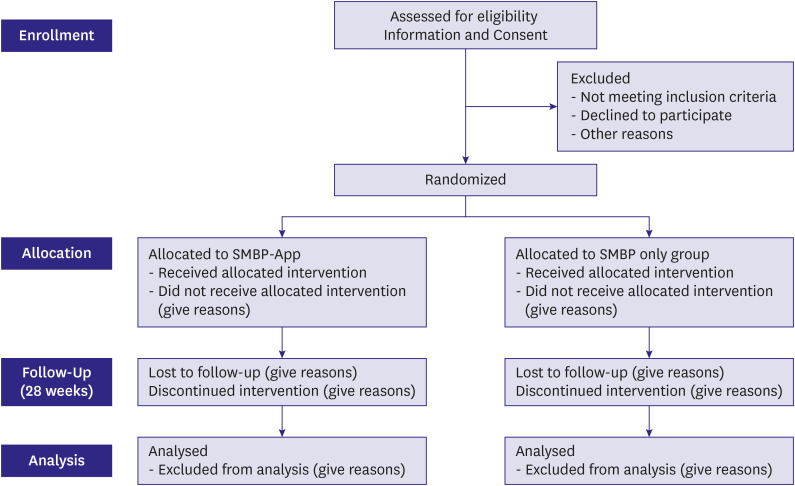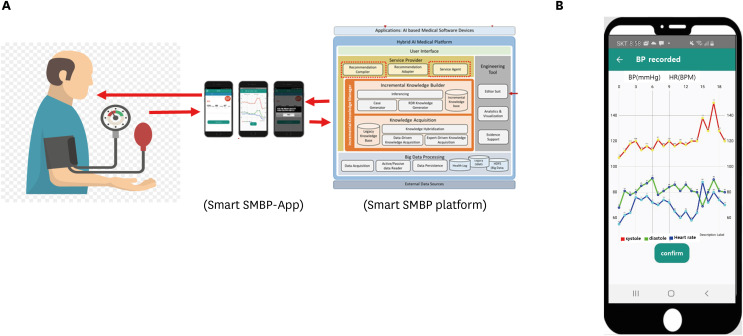Korean Circ J.
2022 Oct;52(10):785-794. 10.4070/kcj.2022.0133.
Self-Monitoring of Blood Pressure and Feed-back Using APP in TReatment of UnconTrolled Hypertension (SMART-BP): A Randomized Clinical Trial
- Affiliations
-
- 1Division of Cardiology, Department of Internal Medicine, Seoul National University Bundang Hospital, Seongnam, Korea
- 2Division of Cardiology, Heart Vascular Stroke Institute, Samsung Medical Center/Sungkyunkwan University School of Medicine, Seoul, Korea
- 3Division of Cardiology, Hallym University Sacred Heart Hospital/Hallym University College of Medicine, Anyang, Korea
- 4Cardiovascular Center, Korea University Guro Hospital, Seoul, Korea
- 5Division of Cardiology, Kyung Hee University Hospital, Seoul, Korea
- 6Department of Computer Science and Engineering, Kyung Hee University, Yongin, Korea
- KMID: 2534043
- DOI: http://doi.org/10.4070/kcj.2022.0133
Abstract
- Background and Objectives
Self-monitoring of blood pressure (SMBP) is a reliable method used to assess BP accurately. However, patients do not often know how to respond to the measured BP value. We developed a mobile application-based feed-back algorithm (SMBPApp) for tailored recommendations. In this study, we aim to evaluate whether SMBP-App is superior to SMBP alone in terms of BP reduction and drug adherence improvement in patients with hypertension.
Methods
Self-Monitoring of blood pressure and Feed-back using APP in TReatment of UnconTrolled Hypertension (SMART-BP) is a prospective, randomized, open-label, multicenter trial to evaluate the efficacy of SMBP-App compared with SMBP alone. Patients with uncomplicated essential hypertension will be randomly assigned to the SMBP-App (90 patients) and SMBP alone (90 patients) groups. In the SMBP group, the patients will perform home BP measurement and receive the standard care, whereas in the SMBP-App group, the patients will receive additional recommendations from the application in response to the obtained BP value. Follow-up visits will be scheduled at 12 and 24 weeks after randomization. The primary endpoint of the study is the mean home systolic BP. The secondary endpoints include the drug adherence, the home diastolic BP, home and office BP.
Conclusions
SMART-BP is a prospective, randomized, open-label, multicenter trial to evaluate the efficacy of SMBP-App. If we can confirm its efficacy, SMBP-App may be scaled-up to improve the treatment of hypertension. Trial Registration: ClinicalTrials.gov Identifier: NCT04470284
Figure
Reference
-
1. Lewington S, Clarke R, Qizilbash N, et al. Age-specific relevance of usual blood pressure to vascular mortality: a meta-analysis of individual data for one million adults in 61 prospective studies. Lancet. 2002; 360:1903–1913. PMID: 12493255.2. Park JK, Lim YH, Kim KS, et al. Changes in body fat distribution through menopause increase blood pressure independently of total body fat in middle-aged women: the Korean National Health and Nutrition Examination Survey 2007–2010. Hypertens Res. 2013; 36:444–449. PMID: 23235715.3. Correction to: heart disease and stroke statistics-2017 update: a report from the American Heart Association. Circulation. 2017; 136:e196. PMID: 28874428.4. Adler AI, Stratton IM, Neil HA, et al. Association of systolic blood pressure with macrovascular and microvascular complications of type 2 diabetes (UKPDS 36): prospective observational study. BMJ. 2000; 321:412–419. PMID: 10938049.5. Wright JT Jr, Williamson JD, Whelton PK, et al. A randomized trial of intensive versus standard blood-pressure control. N Engl J Med. 2015; 373:2103–2116. PMID: 26551272.6. Hajjar I, Kotchen TA. Trends in prevalence, awareness, treatment, and control of hypertension in the United States, 1988–2000. JAMA. 2003; 290:199–206. PMID: 12851274.7. Nieuwlaat R, Wilczynski N, Navarro T, et al. Interventions for enhancing medication adherence. Cochrane Database Syst Rev. 2014; (11):CD000011. PMID: 25412402.8. Fletcher BR, Hartmann-Boyce J, Hinton L, McManus RJ. The effect of self-monitoring of blood pressure on medication adherence and lifestyle factors: a systematic review and meta-analysis. Am J Hypertens. 2015; 28:1209–1221. PMID: 25725092.9. Unger T, Borghi C, Charchar F, et al. 2020 International Society of Hypertension global hypertension practice guidelines. J Hypertens. 2020; 38:982–1004. PMID: 32371787.10. Tucker KL, Sheppard JP, Stevens R, et al. Self-monitoring of blood pressure in hypertension: a systematic review and individual patient data meta-analysis. PLoS Med. 2017; 14:e1002389. PMID: 28926573.11. Benetti E, Fania C, Palatini P. Validation of the A&D BP UA-651 device with a wide-range cuff for home blood pressure measurement according to the European Society of Hypertension International Protocol revision 2010. Blood Press Monit. 2015; 20:164–167. PMID: 25536400.12. Rinfret S, Lussier MT, Peirce A, et al. The impact of a multidisciplinary information technology-supported program on blood pressure control in primary care. Circ Cardiovasc Qual Outcomes. 2009; 2:170–177. PMID: 20031834.13. He J, Irazola V, Mills KT, et al. Effect of a community health worker-led multicomponent intervention on blood pressure control in low-income patients in argentina: a randomized clinical trial. JAMA. 2017; 318:1016–1025. PMID: 28975305.14. Lim SS, Vos T, Flaxman AD, et al. A comparative risk assessment of burden of disease and injury attributable to 67 risk factors and risk factor clusters in 21 regions, 1990-2010: a systematic analysis for the Global Burden of Disease Study 2010. Lancet. 2012; 380:2224–2260. PMID: 23245609.15. Stratton IM, Adler AI, Neil HA, et al. Association of glycaemia with macrovascular and microvascular complications of type 2 diabetes (UKPDS 35): prospective observational study. BMJ. 2000; 321:405–412. PMID: 10938048.16. Chobanian AV, Bakris GL, Black HR, et al. The seventh report of the Joint National Committee on Prevention, Detection, Evaluation, and Treatment of High Blood Pressure: the JNC 7 report. JAMA. 2003; 289:2560–2572. PMID: 12748199.17. Neal B, MacMahon S, Chapman N. Blood Pressure Lowering Treatment Trialists' Collaboration. Effects of ACE inhibitors, calcium antagonists, and other blood-pressure-lowering drugs: results of prospectively designed overviews of randomised trials. Lancet. 2000; 356:1955–1964. PMID: 11130523.18. Psaty BM, Smith NL, Siscovick DS, et al. Health outcomes associated with antihypertensive therapies used as first-line agents. A systematic review and meta-analysis. JAMA. 1997; 277:739–745. PMID: 9042847.19. Ogedegbe G, Schoenthaler A. A systematic review of the effects of home blood pressure monitoring on medication adherence. J Clin Hypertens (Greenwich). 2006; 8:174–180. PMID: 16522994.20. Morawski K, Ghazinouri R, Krumme A, et al. Association of a smartphone application with medication adherence and blood pressure control: the MedISAFE-BP randomized clinical trial. JAMA Intern Med. 2018; 178:802–809. PMID: 29710289.21. Moore JO, Marshall MA, Judge D, et al. Technology-supported apprenticeship in the management of hypertension: a randomized controlled trial. J Clin Outcomes Manag. 2014; 21:110–122.22. Choi DJ, Park JJ, Ali T, Lee S. Artificial intelligence for the diagnosis of heart failure. NPJ Digit Med. 2020; 3:54. PMID: 32285014.23. Park JJ, Lee CJ, Park SJ, et al. Heart failure statistics in Korea, 2020: a report from the Korean Society of Heart Failure. Int J Heart Fail. 2021; 3:224.
- Full Text Links
- Actions
-
Cited
- CITED
-
- Close
- Share
- Similar articles
-
- Clinical Implications of Ambulatory and Home Blood Pressure Monitoring
- Optimal blood pressure target and measurement in patients with chronic kidney disease
- Office Blood Pressure is Higher than Home Blood Pressure, and Digital Electronic Sphygmomanometer is Useful for Self-Monitoring of Blood Pressure in Hypertensive Patients
- Comparison of Office Blood Pressure, Automated Unattended Office Blood Pressure, Home Blood Pressure, and 24-Hour Ambulatory Blood Pressure Measurements
- Clinical Significance and Therapeutic Implication of Nocturnal Hypertension: Relationship between Nighttime Blood Pressure and Quality of Sleep



